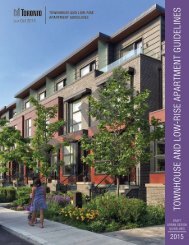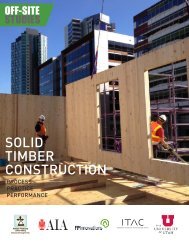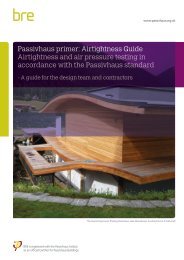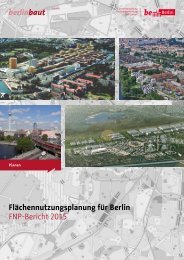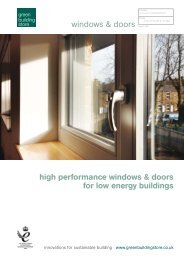TRUE URBAN SPIRIT
b008379b
b008379b
Create successful ePaper yourself
Turn your PDF publications into a flip-book with our unique Google optimized e-Paper software.
GLOSSARY<br />
Lower Austria for intensified co-operation<br />
across provincial borders to improve<br />
the exploitation of development potentials<br />
of the urban region. City-Environs Management<br />
is embedded in the association<br />
“Niederösterreich/Wien − gemeinsame<br />
Entwicklungsräume” and is concerned<br />
with planning and management tasks that<br />
affect both Vienna and the neighbouring<br />
municipalities in Lower Austria. This on<br />
the one hand involves issues of joint strategic<br />
regional development and on the<br />
other hand touches on concrete joint projects.<br />
Superordinate green corridors<br />
Superordinate green corridors are contiguous<br />
open spaces that can serve social,<br />
ecological and climatological functions.<br />
They provide the local population with<br />
open spaces near their homes, create and<br />
safeguard habitats for animals and plants<br />
and network these, foster traffic avoidance<br />
by means of good accessibility and<br />
moreover benefit the generation and<br />
transport of fresh air.<br />
Two-tiered developers’ competitions<br />
Developers’ competitions are a time-tried<br />
instrument of subsidised housing construction<br />
in Vienna. They play a key role in<br />
safeguarding high quality in housing construction<br />
and ensure efficient and costeffective<br />
solutions. Two-tiered developers’<br />
competitions further evolve this successful<br />
instrument. They allow for the gradual<br />
development of optimised urbanistic,<br />
architectural and functional solutions<br />
while involving municipal experts, teams<br />
of architects and project developers.<br />
University Location Vienna Concept<br />
The University Location Vienna Concept<br />
analysed the interactions between university<br />
sites and urban development. The<br />
analysis showed that Vienna disposes of<br />
a sufficient number of locations suitable<br />
for universities.<br />
Urban technologies<br />
This term covers products and services in<br />
such thematic areas as telecommunica-<br />
tions, transport and mobility, energy<br />
and environment, supply and disposal,<br />
construction and housing as well as conservation.<br />
They are one focal point of<br />
Vienna’s urban research activities and of<br />
the Technology Agency of the City of<br />
Vienna.<br />
Vienna Business Agency<br />
The Vienna Business Agency is the central<br />
point of the City of Vienna for both Austrian<br />
and foreign enterprises, company<br />
founders and investors. The task and<br />
objective of this institution lie in strengthening<br />
Vienna’s enterprises and their<br />
innovative clout as well as in sustainably<br />
modernising Vienna as a business location.<br />
Together with its subsidiaries, the<br />
Vienna Business Agency supports the<br />
implementation of innovative growth projects<br />
by offering financial incentives,<br />
customised counselling and business<br />
infrastructure.<br />
Vienna Campus Model and Vienna<br />
Campus plus Model / campus sites<br />
The Vienna Campus Model and its successor,<br />
the Vienna Campus plus Model,<br />
concentrate kindergartens, schools and<br />
leisure education in one location. Campus<br />
plus sites opt increasingly for the networking<br />
of individual educational institutions<br />
as well as for the integration of further<br />
partners within the education sector,<br />
e. g. Music Schools of the City of Vienna,<br />
mass sports, youth centres and other<br />
neighbourhood service providers. Multiple<br />
use is aimed for in as many areas as possible.<br />
Thus Campus plus is an all-inclusive<br />
educational facility for children aged<br />
0 to 10 years that is steeped in a comprehensive<br />
and holistic concept of education.<br />
Vienna Charter<br />
The Vienna Charter was launched in<br />
March 2012 and constituted a hitherto<br />
unique citizen participation project in<br />
Europe. Pursuing the objective of jointly<br />
shaping good-neighbourly relations in<br />
Vienna, a total of 8,500 Viennese conduct<br />
ed discussions in 651 groups to voice<br />
their ideas. The Charter process was initi-<br />
ated by the City of Vienna and implemented<br />
together with over 325 partner<br />
organisations. The preamble to the<br />
Charter reads, “Vienna is home: for<br />
women and men, for young and old, for<br />
those who were born here and for those<br />
who moved to the city, for people with<br />
different worldviews, beliefs and needs.<br />
To get along well, we need to respect each<br />
other. Respect means accepting other<br />
people the way they are – as we ourselves<br />
wish to be accepted and respected.<br />
Human rights are our common basis.”<br />
Vienna Region<br />
VIENNA REGION Marketing GmbH is a<br />
public company established in 2008<br />
and owned by the Federal Provinces of<br />
Vienna, Lower Austria and Burgenland.<br />
It is the purpose of this enterprise to<br />
inter nationally position and market the<br />
Vienna Region as a business and technology<br />
location. The supraregional platform<br />
“VIENNA REGION Wirtschaft.Raum.<br />
Entwicklung GmbH” serves as an instrument<br />
to co-ordinate co-operation and<br />
facilitate knowledge transfer between the<br />
federal provinces.<br />
Vienna’s open space network<br />
Vienna’s open space network comprises<br />
the city’s main network of priority green<br />
and open space corridors that are of<br />
importance for the city as a whole and<br />
hence must be sustainably protected and<br />
adequately designed. The open space<br />
network was defined by taking account of<br />
four main functions of urban open and<br />
green spaces: everyday functions (significance<br />
of open and green spaces as key<br />
axes and spaces of movement on foot or<br />
by bike, as central places of social contacts<br />
and as spaces of experience, leisure<br />
and relaxation), structuring of the urban<br />
fabric (significance of open and green<br />
spaces for the structuring of the urban<br />
fabric, orientation and identity creation),<br />
functions for urban ecology (significance<br />
of open and green spaces for the urban<br />
climate, air quality and groundwater<br />
recharge), nature conservation functions<br />
(significance of open and green spaces as<br />
140



